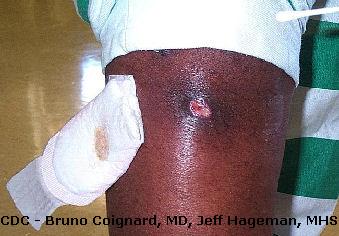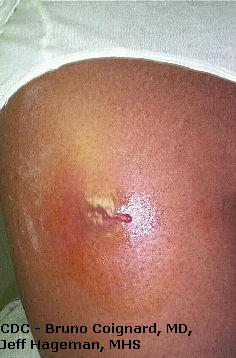Can Having Pus Spots in the Back of Your Throat With Slight Irritation Be Something Serious
Bacterial Skin Infections: Impetigo and MRSA
What kinds of bacteria can cause contagious skin infections?
Certain bacteria commonly live on the skin of many people without causing harm. However, these bacteria can cause skin infections if they enter the body through cuts, open wounds, or other breaks in the skin. Symptoms may include redness, swelling, pain, or pus.
How serious are bacterial skin infections?
While many bacterial skin infections are mild and easily treatable, some can become very serious and even life threatening. In addition, some bacterial infections can be spread to others. This is why prevention is so important.
What are the two most common bacteria that cause skin infections?
- Group A Streptococcus (GAS), often called "strep."
- Staphylococcus aureus, commonly called "staph."
Impetigo
What is impetigo?
Impetigo is a common bacterial skin infection caused by Group A Streptococcus (GAS) or "strep."
What is Group A Streptococcus (GAS)?
Group A Streptococcus (GAS) or "strep" is a common bacterium (bacterium is the singular form of the plural, bacteria) that is found on the skin or in the throat ("strep throat"). People can carry GAS and have no symptoms of illness or they may develop relatively mild skin infections, including impetigo.
How does impetigo spread?
Group A Streptococcus (GAS) or "strep" can be transmitted through direct person-to-person contact with someone who has the infection. GAS can also be picked up indirectly through contact with an item (such as a wrestling mat, gear, towel, razor, or cell phone) that is contaminated with the bacterium.
What are the symptoms of impetigo?
- Symptoms usually began 1-3 days after infection.
- Sores (lesions) begin as small red spots, usually on the face (especially around the nose and mouth), but can appear anywhere on the body.
- The sores are often itchy, but usually not painful.
- The sores develop into blisters that break open and ooze fluid -- this fluid contains infectious bacteria that can infect others if they have contact with it.
- After a few days, the ruptured blisters form a flat, thick, honey-colored (yellowish-brown) crust that eventually disappears, leaving red marks that heal without scarring.
- There may be swollen glands (enlarged lymph nodes), but usually no fever.
- Click here to view a photograph of impetigo on the face from DermAtlas.
What should athletes do if they think they have impetigo?
While mild cases of impetigo may be treated without seeing a health care provider, athletes are recommended to have a medical professional determine what type of infection they have, how to treat it, and if it is contagious. If the infection is contagious, athletes should not practice or compete until their medical provider clears them to return.
Back to Top
Back to Table of Contents
Methicillin-Resistant Staphylococcus aureus (MRSA)
What is Staphylococcus aureus?
Staphylococcus aureus ("staph") is a bacterium that is carried on the skin or in the nose of approximately 25% to 30% of healthy people without causing infection -- this is called colonization. Staph bacteria are one of the most common causes of skin infections in the U.S. Most of these skin infections are minor (such as pimples and boils), are not spread to others (not infectious), and usually can be treated without antibiotics. However, some staph bacteria are resistant to certain antibiotics -- one type is called MRSA.
What is MRSA?
MRSA stands for methicillin-resistant Staphylococcus aureus. MRSA is a staph bacterium that certain antibiotics in the penicillin family should be able to treat, but cannot. When the infection is resistant to the medication, it is called resistance. However, other non-penicillin antibiotics can effectively treat most MRSA infections.
 |
| MRSA Infection on Arm |
What causes antibiotic resistance?
Most resistance to antibiotics develops from taking them improperly. Examples are:
- Incomplete use: Not finishing the entire antibiotic prescription (often because people start to feel better and stop taking the medication).
- Inappropriate use: Taking antibiotics for a viral infection (antibiotics do NOT treat viral infections such as colds or the flu).
- Unnecessary use: Taking antibiotics "just in case" (for example, taking them prior to a vacation or special event to try to prevent illness).
It is important to take prescription medication only when prescribed for you by a health professional and to take all the medicine even if you feel better before you have completed the prescription.
How serious is MRSA?
Although health care providers can treat most MRSA skin infections in their offices, MRSA can be very serious and even cause death. MRSA can cause pneumonia or severe infections of the blood, bones, surgical wounds, heart valves, and lungs. MRSA can be fatal if not identified and treated with effective antibiotics.
How does someone get MRSA infection?
Most often, MRSA is transmitted by direct skin-to-skin contact with someone who has the infection.
MRSA can be spread by indirect contact too (for example contact with a mat that has infected drainage on it or by sharing a towel or cell phone with someone who has MRSA). Because of this, never share personal hygiene and health items.
Where on the skin does MRSA appear and what are the symptoms?
MRSA infections commonly occur where there is a break in the skin (for example, a cut or wound), especially in areas covered by hair (for example, the beard area, back of the neck, armpit, groin, legs, or buttocks)
MRSA may look like a bump on the skin that may be red, swollen, warm to the touch, painful, filled with pus, or draining. The pus or drainage contains the infectious bacteria that can be spread to others. People with MRSA may have a fever.
 |
| MRSA Infection on Thigh |
How is MRSA diagnosed and treated?
Depending on your symptoms, your health care provider may send a nasal swab or skin tissue specimen to a laboratory to identify the infection or confirm that you have MRSA.
Your health care provider may drain the pus from the lesion -- do not do this yourself.
If you are prescribed an antibiotic, take it exactly as directed and take all of the medicine even if the infection improves or goes away before you have finished the entire prescription. If the infection does not begin to improve within a few days, contact your health care provider.
Back to Top
Back to Table of Contents
Can Having Pus Spots in the Back of Your Throat With Slight Irritation Be Something Serious
Source: https://www.health.ny.gov/diseases/communicable/athletic_skin_infections/bacterial.htm
0 Response to "Can Having Pus Spots in the Back of Your Throat With Slight Irritation Be Something Serious"
Post a Comment